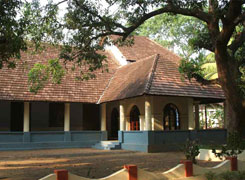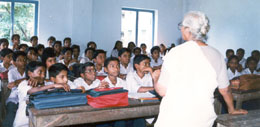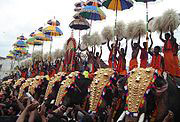Malayalam (മലയാളം malayāḷaṁ) is a Dravidian language used predominantly in the state of Kerala, in southern India. It is one of the 22 official languages of India, and it is used by around 36 million people. Malayalam is also widely used in the union territories of Lakshadweep and Mahé, the Kanyakumari district of Tamil Nadu, and Dakshina Kannada, and Kodagu districts of Karnataka. It is also used by a large population of Indian expatriates living in Arab States, the United Kingdom, the United States,Singapore, Australia, and Canada. Malayalam formed out of Proto-Dravidian rather late and began developing a body of literature by the 9th century CE.  Before Malayalam came into being, Proto-Dravidian was used in literature and courts of a region called Tamilakam. The modern Tamil language also developed from this Proto-Dravidian. Malayalam uses a large proportion of Sanskrit vocabulary. Loans have also been made from Portuguese, Arabic, Syriac, and in more recent times English. The predominant spoken language in Kerala is Malayalam, most of whose speakers live in Kerala. Malayalam literature is ancient in origin, and includes such figures as the 14th century Niranam poets (Madhava Panikkar, Sankara Panikkar and Rama Panikkar), and the 17th century poet Thunchaththu Ezhuthachan whose works mark the dawn of both modern Malayalam language and indigenous Keralite poetry. The "triumvirate of poets" (Kavithrayam), Kumaran Asan, Vallathol Narayana Menon, and Ulloor S. Parameswara Iyer, are recognised for moving Keralite poetry away from archaic sophistry and metaphysics, and towards a more lyrical mode. In the second half of the 20th century, Jnanpith awardees like G. Sankara Kurup, S. K. Pottekkatt, Thakazhi Sivasankara Pillai and M. T. Vasudevan Nair have made valuable contributions to the Malayalam literature. Later, such Keralite writers as O. V. Vijayan, Kamaladas, M. Mukundan, and Booker Prize winner Arundhati Roy, whose 1996 semi-autobiographical bestseller The God of Small Things is set in the Kottayam town of Ayemenem, have gained international recognition. Before Malayalam came into being, Proto-Dravidian was used in literature and courts of a region called Tamilakam. The modern Tamil language also developed from this Proto-Dravidian. Malayalam uses a large proportion of Sanskrit vocabulary. Loans have also been made from Portuguese, Arabic, Syriac, and in more recent times English. The predominant spoken language in Kerala is Malayalam, most of whose speakers live in Kerala. Malayalam literature is ancient in origin, and includes such figures as the 14th century Niranam poets (Madhava Panikkar, Sankara Panikkar and Rama Panikkar), and the 17th century poet Thunchaththu Ezhuthachan whose works mark the dawn of both modern Malayalam language and indigenous Keralite poetry. The "triumvirate of poets" (Kavithrayam), Kumaran Asan, Vallathol Narayana Menon, and Ulloor S. Parameswara Iyer, are recognised for moving Keralite poetry away from archaic sophistry and metaphysics, and towards a more lyrical mode. In the second half of the 20th century, Jnanpith awardees like G. Sankara Kurup, S. K. Pottekkatt, Thakazhi Sivasankara Pillai and M. T. Vasudevan Nair have made valuable contributions to the Malayalam literature. Later, such Keralite writers as O. V. Vijayan, Kamaladas, M. Mukundan, and Booker Prize winner Arundhati Roy, whose 1996 semi-autobiographical bestseller The God of Small Things is set in the Kottayam town of Ayemenem, have gained international recognition.
 The term "Malayalam" comes from the words mala (Mountain), alam (Place). Hence malayali means Mountain people who lived beyond the Western Ghats, and Malayalam the language that was spoken there. Another etymology is that it comes from mala (Mountain) and azham (Ocean) - referring to the Sahya mountains and Arabian Sea that bound Kerala. Malayazham later became Malayalam. The word "Malayalam" is spelled as a palindrome in English. However, it is not a palindrome in its own language, for three reasons: the next to last vowel is long and should properly be spelled double or written ā (an a with a macron); the 'l' consonants represent different sounds, the first being dental (Malayalam ല, Roman l) (although the consonant chart below lists that sound as [alveolar]) and the second retroflex ([ ɭ ], Malayalam ള, Roman ḷ); and the final 'm' is a mark of nasalization, unlike the initial 'm', which is a full consonant. According to the UCLA language institute, it is the Dravidian language most influenced by Sanskrit. The term "Malayalam" comes from the words mala (Mountain), alam (Place). Hence malayali means Mountain people who lived beyond the Western Ghats, and Malayalam the language that was spoken there. Another etymology is that it comes from mala (Mountain) and azham (Ocean) - referring to the Sahya mountains and Arabian Sea that bound Kerala. Malayazham later became Malayalam. The word "Malayalam" is spelled as a palindrome in English. However, it is not a palindrome in its own language, for three reasons: the next to last vowel is long and should properly be spelled double or written ā (an a with a macron); the 'l' consonants represent different sounds, the first being dental (Malayalam ല, Roman l) (although the consonant chart below lists that sound as [alveolar]) and the second retroflex ([ ɭ ], Malayalam ള, Roman ḷ); and the final 'm' is a mark of nasalization, unlike the initial 'm', which is a full consonant. According to the UCLA language institute, it is the Dravidian language most influenced by Sanskrit.
 In the early ninth century vattezhuthu (round writing) traceable through the Grantha script, to the pan-Indian Brāhmī script, gave rise to the Malayalam writing system. It is syllabic in the sense that the sequence of graphic elements means that syllables have to be read as units, though in this system the elements representing individual vowels and consonants are for the most part readily identifiable. In the 1960s Malayalam dispensed with many special letters representing less frequent conjunct consonants and combinations of the vowel /u/ with different consonants. Malayalam language script consists of 53 letters including 16 vowels and 37 consonants. The earlier style of writing is now substituted with a new style from 1981. This new script reduces the different letters for typeset from 900 to fewer than 90. This was mainly done to include Malayalam in the keyboards of typewriters and computers. In 1999 a group called Rachana Akshara Vedi, led by Chitrajakumar, and K.H. Hussein, produced a set of free fonts containing the entire character repertoire of more than 900 glyphs. This was announced and released along with an editor in the same year at Thiruvananthapuram, the capital of Kerala. In 2004, the fonts were released under the GNU GPL license by Richard Stallman of the Free Software Foundation at the Cochin University of Science and Technology in Kochi, Kerala. In the early ninth century vattezhuthu (round writing) traceable through the Grantha script, to the pan-Indian Brāhmī script, gave rise to the Malayalam writing system. It is syllabic in the sense that the sequence of graphic elements means that syllables have to be read as units, though in this system the elements representing individual vowels and consonants are for the most part readily identifiable. In the 1960s Malayalam dispensed with many special letters representing less frequent conjunct consonants and combinations of the vowel /u/ with different consonants. Malayalam language script consists of 53 letters including 16 vowels and 37 consonants. The earlier style of writing is now substituted with a new style from 1981. This new script reduces the different letters for typeset from 900 to fewer than 90. This was mainly done to include Malayalam in the keyboards of typewriters and computers. In 1999 a group called Rachana Akshara Vedi, led by Chitrajakumar, and K.H. Hussein, produced a set of free fonts containing the entire character repertoire of more than 900 glyphs. This was announced and released along with an editor in the same year at Thiruvananthapuram, the capital of Kerala. In 2004, the fonts were released under the GNU GPL license by Richard Stallman of the Free Software Foundation at the Cochin University of Science and Technology in Kochi, Kerala.
|
 Before Malayalam came into being, Proto-Dravidian was used in literature and courts of a region called Tamilakam. The modern Tamil language also developed from this Proto-Dravidian. Malayalam uses a large proportion of Sanskrit vocabulary. Loans have also been made from Portuguese, Arabic, Syriac, and in more recent times English. The predominant spoken language in Kerala is Malayalam, most of whose speakers live in Kerala. Malayalam literature is ancient in origin, and includes such figures as the 14th century Niranam poets (Madhava Panikkar, Sankara Panikkar and Rama Panikkar), and the 17th century poet Thunchaththu Ezhuthachan whose works mark the dawn of both modern Malayalam language and indigenous Keralite poetry. The "triumvirate of poets" (Kavithrayam), Kumaran Asan, Vallathol Narayana Menon, and Ulloor S. Parameswara Iyer, are recognised for moving Keralite poetry away from archaic sophistry and metaphysics, and towards a more lyrical mode. In the second half of the 20th century, Jnanpith awardees like G. Sankara Kurup, S. K. Pottekkatt, Thakazhi Sivasankara Pillai and M. T. Vasudevan Nair have made valuable contributions to the Malayalam literature. Later, such Keralite writers as O. V. Vijayan, Kamaladas, M. Mukundan, and Booker Prize winner Arundhati Roy, whose 1996 semi-autobiographical bestseller The God of Small Things is set in the Kottayam town of Ayemenem, have gained international recognition.
Before Malayalam came into being, Proto-Dravidian was used in literature and courts of a region called Tamilakam. The modern Tamil language also developed from this Proto-Dravidian. Malayalam uses a large proportion of Sanskrit vocabulary. Loans have also been made from Portuguese, Arabic, Syriac, and in more recent times English. The predominant spoken language in Kerala is Malayalam, most of whose speakers live in Kerala. Malayalam literature is ancient in origin, and includes such figures as the 14th century Niranam poets (Madhava Panikkar, Sankara Panikkar and Rama Panikkar), and the 17th century poet Thunchaththu Ezhuthachan whose works mark the dawn of both modern Malayalam language and indigenous Keralite poetry. The "triumvirate of poets" (Kavithrayam), Kumaran Asan, Vallathol Narayana Menon, and Ulloor S. Parameswara Iyer, are recognised for moving Keralite poetry away from archaic sophistry and metaphysics, and towards a more lyrical mode. In the second half of the 20th century, Jnanpith awardees like G. Sankara Kurup, S. K. Pottekkatt, Thakazhi Sivasankara Pillai and M. T. Vasudevan Nair have made valuable contributions to the Malayalam literature. Later, such Keralite writers as O. V. Vijayan, Kamaladas, M. Mukundan, and Booker Prize winner Arundhati Roy, whose 1996 semi-autobiographical bestseller The God of Small Things is set in the Kottayam town of Ayemenem, have gained international recognition. The term "Malayalam" comes from the words mala (Mountain), alam (Place). Hence malayali means Mountain people who lived beyond the Western Ghats, and Malayalam the language that was spoken there. Another etymology is that it comes from mala (Mountain) and azham (Ocean) - referring to the Sahya mountains and Arabian Sea that bound Kerala. Malayazham later became Malayalam. The word "Malayalam" is spelled as a palindrome in English. However, it is not a palindrome in its own language, for three reasons: the next to last vowel is long and should properly be spelled double or written ā (an a with a macron); the 'l' consonants represent different sounds, the first being dental (Malayalam ല, Roman l) (although the consonant chart below lists that sound as [alveolar]) and the second retroflex ([ ɭ ], Malayalam ള, Roman ḷ); and the final 'm' is a mark of nasalization, unlike the initial 'm', which is a full consonant. According to the UCLA language institute, it is the Dravidian language most influenced by Sanskrit.
The term "Malayalam" comes from the words mala (Mountain), alam (Place). Hence malayali means Mountain people who lived beyond the Western Ghats, and Malayalam the language that was spoken there. Another etymology is that it comes from mala (Mountain) and azham (Ocean) - referring to the Sahya mountains and Arabian Sea that bound Kerala. Malayazham later became Malayalam. The word "Malayalam" is spelled as a palindrome in English. However, it is not a palindrome in its own language, for three reasons: the next to last vowel is long and should properly be spelled double or written ā (an a with a macron); the 'l' consonants represent different sounds, the first being dental (Malayalam ല, Roman l) (although the consonant chart below lists that sound as [alveolar]) and the second retroflex ([ ɭ ], Malayalam ള, Roman ḷ); and the final 'm' is a mark of nasalization, unlike the initial 'm', which is a full consonant. According to the UCLA language institute, it is the Dravidian language most influenced by Sanskrit. In the early ninth century vattezhuthu (round writing) traceable through the Grantha script, to the pan-Indian Brāhmī script, gave rise to the Malayalam writing system. It is syllabic in the sense that the sequence of graphic elements means that syllables have to be read as units, though in this system the elements representing individual vowels and consonants are for the most part readily identifiable. In the 1960s Malayalam dispensed with many special letters representing less frequent conjunct consonants and combinations of the vowel /u/ with different consonants. Malayalam language script consists of 53 letters including 16 vowels and 37 consonants. The earlier style of writing is now substituted with a new style from 1981. This new script reduces the different letters for typeset from 900 to fewer than 90. This was mainly done to include Malayalam in the keyboards of typewriters and computers. In 1999 a group called Rachana Akshara Vedi, led by Chitrajakumar, and K.H. Hussein, produced a set of free fonts containing the entire character repertoire of more than 900 glyphs. This was announced and released along with an editor in the same year at Thiruvananthapuram, the capital of Kerala. In 2004, the fonts were released under the GNU GPL license by Richard Stallman of the Free Software Foundation at the Cochin University of Science and Technology in Kochi, Kerala.
In the early ninth century vattezhuthu (round writing) traceable through the Grantha script, to the pan-Indian Brāhmī script, gave rise to the Malayalam writing system. It is syllabic in the sense that the sequence of graphic elements means that syllables have to be read as units, though in this system the elements representing individual vowels and consonants are for the most part readily identifiable. In the 1960s Malayalam dispensed with many special letters representing less frequent conjunct consonants and combinations of the vowel /u/ with different consonants. Malayalam language script consists of 53 letters including 16 vowels and 37 consonants. The earlier style of writing is now substituted with a new style from 1981. This new script reduces the different letters for typeset from 900 to fewer than 90. This was mainly done to include Malayalam in the keyboards of typewriters and computers. In 1999 a group called Rachana Akshara Vedi, led by Chitrajakumar, and K.H. Hussein, produced a set of free fonts containing the entire character repertoire of more than 900 glyphs. This was announced and released along with an editor in the same year at Thiruvananthapuram, the capital of Kerala. In 2004, the fonts were released under the GNU GPL license by Richard Stallman of the Free Software Foundation at the Cochin University of Science and Technology in Kochi, Kerala.

